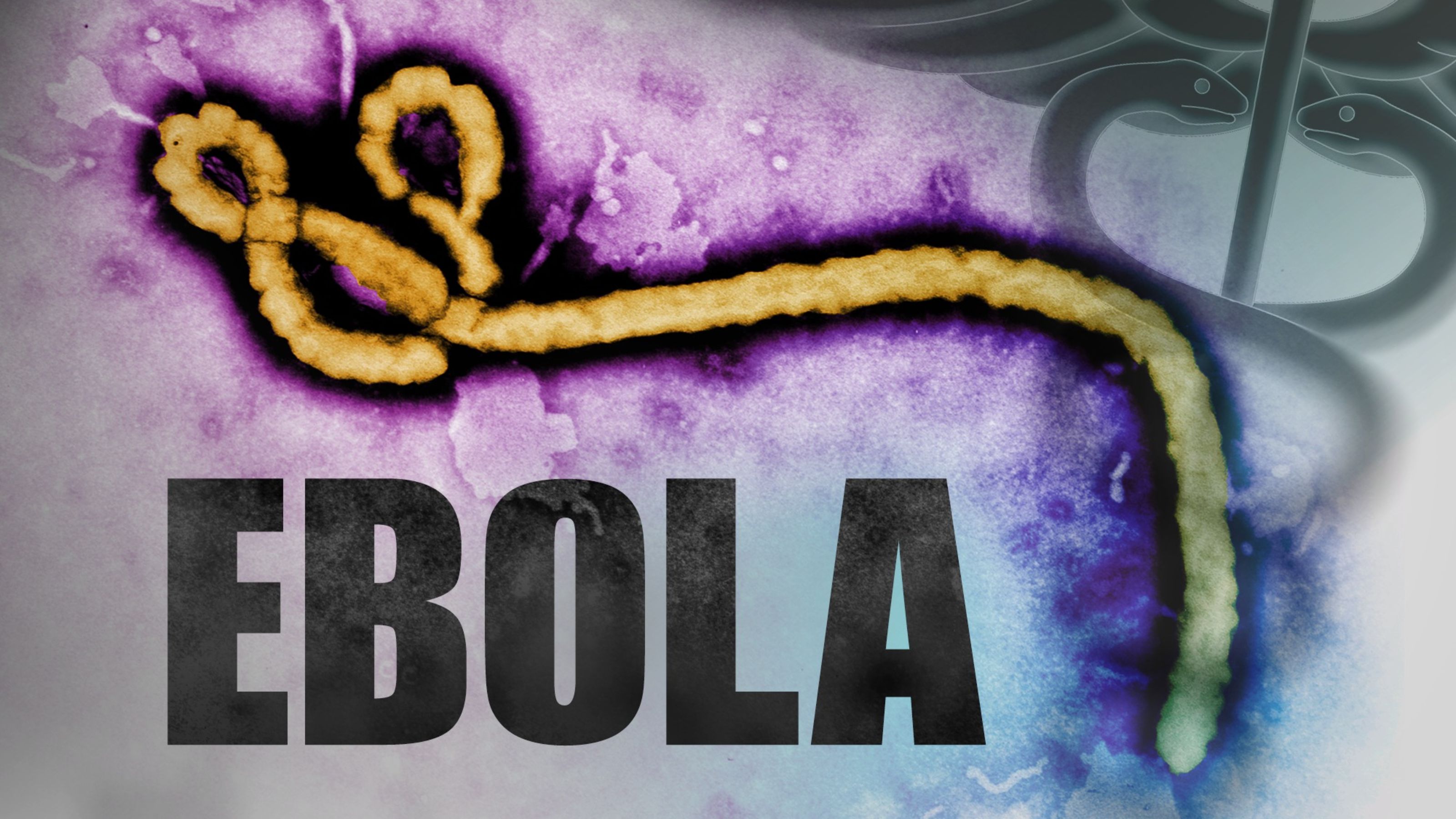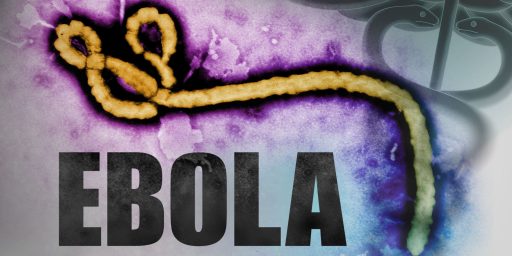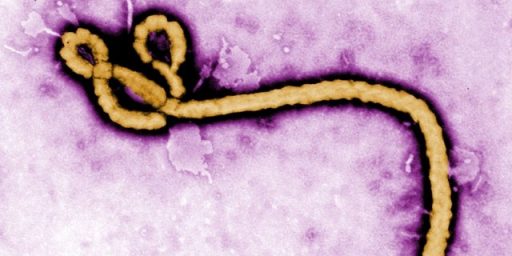Ebola Outbreak Still A Problem In Central Africa
The Ebola outbreak that began last year in the Democratic Republic of the Congo is still a problem, and still threatening to spread.

The Editors at The New York Times note that the ongoing battle against the Ebola virus that has been going on in the Democratic Republic of Congo is not going well and that there’s a very real threat that it could spread to a wider and harder to control outbreak:
Ebola is ravaging the northeastern Democratic Republic of Congo, a country riven by violent conflict and neglected for decades by the international community. The World Health Organization has less than half of the $98 million it needs to confront the crisis. And the United States government has undermined its own experts with a slow-footed response and cumbersome aid restrictions.
More than 2,100 people have been infected in the current outbreak, first reported in August of last year, and nearly 1,500 of them have died. Those numbers still pale in comparison to the Ebola outbreak that began in 2014, during which more than 28,000 people were infected and more than 11,000 died. That’s in part because the current outbreak has benefited from a newly available Ebola vaccine and a quicker, better coordinated response from the World Health Organization.
But experts worry that the worst is yet to come. Hundreds of thousands of people are fleeing the region in response to ethnic violence, potentially carrying the virus far beyond Congo’s borders. The outbreak has already spread into neighboring Uganda; if it reaches South Sudan, a country dotted with refugee camps and teeming with instability, containment could become nearly impossible.
To prevent that from happening, health care workers will have to eradicate the deep mistrust within Congo’s borders. Rumors abound that the virus was brought to the country by aid workers or that it is a hoax devised by the country’s government to prevent certain districts from voting in the recent presidential election. Such suspicions have led many to avoid Ebola treatment centers, hide sick family members from foreign doctors and refuse to cooperate with other control measures.
(…)
However, such far-reaching programs were effectively prohibited last fall when the Trump administration restricted nonemergency aid to Congo. The administration said that the restriction was meant to penalize the country for its failure to curb human trafficking and that the Ebola response would not be affected. But it’s unclear whether any portion of U.S.A.I.D.’s more ambitious agenda will be allowed to proceed.
The administration would do well to lift that restriction. Even better: Congress could amend current human trafficking lawsto prevent them from being weaponized in this way. Human trafficking is an abomination, but withholding development aid will hardly solve that crisis.
Last week, more than 10 months after Congo’s Ebola outbreak began, the Trump administration activated the Centers for Disease Control and Prevention’s emergency operations center. That’s a welcome move — it will enable the agency to quickly deploy many more resources to the crisis. But it would have been far more effective before hundreds of thousands of Congolese began fleeing the region.
The United States is not the only country that could do more to address the current crisis. The W.H.O. has been much more effective in this outbreak than during previous ones, but its efforts are still being stymied by a colossal funding shortfall. The organization’s decision-making body created a global contingency fund in 2015, after the last major Ebola outbreak, to avoid exactly this situation — but contributions to that fund have fallen far short of what is needed.
More from The Washington Post:
A dozen young men revved their motorcycle engines in front of the wooden gate of a makeshift checkpoint — too impatient to have their temperatures checked or to wash their hands with chlorinated water. Health workers manning the post had little choice but to let them pass.
Every day, thousands of people travel this road through the epicenter of Congo’s ongoing Ebola outbreak, where they are supposed to comply with field nurses toting gun-shaped thermometers testing for fevers. But that operation is far from perfect, and extinguishing the nearly year-old outbreak is months away at best. Days with a dozen new cases are normal.
“Ebola is like water. If you don’t build a perfect dam, even a small hole can lead to a flood of new cases,” said Marie Roseline Belizaire, the World Health Organization’s deputy manager for the response.
Health officials are confident the outbreak is not spiraling out of control but are worried the holes in that dam are opening up faster than they can plug them. Along the four international borders near the outbreak zone, hundreds of thousands of people move unimpeded from country to country each day, using countless footpaths that save them the hassle of immigration authorities and, now, health checkpoints.
Although the WHO has repeatedly declined to declare a global health emergency, the countries surrounding Congo are scrambling to find a way to contain the virus.
Health workers fear the looming possibility that Ebola could spread to the Congolese city of Goma, a provincial capital of more than 1 million where as many as 70,000 people cross the border with Rwanda each day.
(…)
Unlike past Ebola outbreaks in Congo, which occurred mostly in remote regions, this one more closely resembles the devastating Ebola epidemic in West Africa that killed more than 11,000 across three closely linked countries between 2014 and 2016. Belizaire said she sends urgent messages each week to colleagues in bordering countries, warning of a possible carrier of the virus headed their way.
Last week, for the first time, confirmed cases of the virus were found to have crossed from Congo to Uganda, before being quickly contained. Thousands of health workers are being vaccinated at Congo’s borders with Uganda, Rwanda and South Sudan, and soon will be in Burundi, too. Contacts of confirmed cases have traveled as far as Dubai and China before they have been tracked down.
As the outbreak continues to grow, authorities are resetting their response to take into account the challenges that “the most complex environment imaginable for an Ebola outbreak” poses, said David Gressly, the United Nations’ recently appointed emergency response coordinator.
People in the area cross borders regularly, in part because the lines are so arbitrary — quite literally boundaries drawn in the dirt by colonial powers that resulted in families, ethnic communities and economically interlocked regions becoming different countries.
That the virus has been contained to a relatively small area within Congo’s North Kivu and Ituri provinces is a testament to the extensive amount of work that has been done. More than 65 million impromptu health checkups have been conducted at checkpoints scattered across this densely populated region since the outbreak began in August.
Still, more than 2,000 people have been infected during the outbreak, two-thirds of whom have died. Even in the best-case scenario put forth by WHO officials, the outbreak has at least three months left before it can be extinguished — the duration of entire previous outbreaks in Congo.
These latest developments come some three months after reports that the fight against the epidemic was not going well. This has been happening notwithstanding the fact that there has been a vaccine against Ebola that was developed in the wake of the 2014 outbreak in western Africa that became something of an international crisis when it began to spread internationally, including into the United States. That vaccine has proven to be as close to 100% effective in halting the spread of the disease as possible. While those results were found as part of controlled experiments rather than use in the field, even a high success rate would be better than nothing and would go a long way toward stopping the rapid spread of the disease, especially in underdeveloped countries such as the DRC where sanitation and the disposal of medical waste are less than ideal and long-standing customs regarding the handling of dead bodies ends up contributing to the spread of the disease.
Based on the reports that have come out since the reports in March about the state of the fight against the disease, it has become clear the main problems that public health authorities are three-fold. First of all, it’s not nearly quite as easy to get beyond long-standing cultural practices and taboos that tend to make it easier for a disease like Ebola to spread as experts may have thought it was. Second, there appears to be a perhaps understandable skepticism about vaccination from people who aren’t sufficiently educated about the actual benefits (and risks) of vaccination in general and the Ebola vaccine in particular. Finally, it appears from the reports that the DRC authorities have been utilizing heavy-handed tactics in an effort to force public compliance. This last development seems like a mistake. A better option would be to educate the populace more effectively about the spread of the disease and the effectiveness of vaccination. These people can already see the impact that Ebola is having on their communities, but forcing them to comply with public health orders at the point of a gun is probably not the best way to get people to cooperate, and more likely to make people suspicious of public health authorities, physicians, nurses, and others attempting to deal with this serious health problem.
Kim Yi Dionne and Laura Seay have a comprehensive round-up of the reasons why this outbreak has been hard to contain:
This is the second-deadliest Ebola outbreak on record. In the 2014-2016 Ebola epidemic in West Africa, health authorities recorded more than 28,000 cases, and more than 11,000 people died.
Why has the current Congolese outbreak been so challenging for the government and other stakeholders to contain? Most reports focus on insecurity in eastern Congo. Analysts have observed a spike in Ebola cases coinciding with organized attacks by armed groups on response teams.
But insecurity isn’t the only challenge hampering Ebola response. Recently published research drawing on data collected in the two deadliest outbreaks suggests one other major factor hampering response: citizen mistrust of government.
(…)
For one thing, insecurity makes delivering medical care and other forms of assistance much more difficult. Armed groups and civilians have attacked health-care workers and facilities responding to the Ebola crisis.
The logistics of getting needed supplies to the region, from vaccines to protective equipment, are extremely challenging. And reaching communities that may be affected, but are located in areas controlled by or beyond rebel lines, can be nearly impossible even for the bravest of health professionals.
While the outbreak continues unabated, the WHO declined to declare a public health emergency of international concern (PHEIC), even after cases emerged last week in Uganda.
One organization supporting the Ebola response in eastern Congo is Doctors Without Borders (known by its French initials — MSF — for Médecins Sans Frontières), a humanitarian organization that provides medical care in emergency situations, including in conflict zones. While MSF’s own staff members have faced violence from armed groups, they also pointed to community mistrust as a serious obstacle to their Ebola response efforts.
A leading health journal, the Lancet Infectious Diseases, recently published an important research article studying how Congolese citizens are navigating the current Ebola outbreak. Surveying a random sample of 961 adults living in Beni and Butembo — cities in eastern Congo affected by the outbreak — the researchers found evidence of how citizens’ mistrust shapes how they respond to the epidemic.
Less than a third of the study participants trusted that local authorities represent their interests (according to the study, citizen trust is even lower as you move up levels of governance). A quarter of the study participants believed that the Ebola outbreak was not real. Study participants with low institutional trust and belief in misinformation had a decreased likelihood of adopting behaviors that would prevent Ebola infection, including acceptance of Ebola vaccines.
These findings are consistent with research that a team of political scientists including MIT’s Lily Tsai found during the West African Ebola outbreak. In their study conducted during the Ebola outbreak in Monrovia, Liberia, they found that Liberians who distrusted government took fewer precautions against Ebola. Those who distrusted government were also less compliant with Ebola control policies.
Considering the fact that leaders in the DRC and, indeed, throughout Africa have done practically everything possible to bolster citizen distrust of government authorities, this doesn’t bode well for efforts to contain Ebola or some other highly infectious disease in virtually any part of the continent. This is especially true of those places where civil war and rebellions that have been flaring hot and cold for decades are still an issue that government authorities and residents must deal with on a regular basis. Without that basic level of trust, citizens are less likely to accept representations from any authority figure about the threat posed by the disease and what they must do to protect themselves and their communities.
The good news, if there is any good news, is that the latest outbreak appears to be staying within a relatively limited geographic area. The first reports of an outbreak in the DRCcame out in the spring of 2017. Last spring, it became apparent that the 2017 outbreak had not been suppressed as easily as previously thought and there were signs that it had hit a major city in the DRC. While those are serious issues, it does not appear that the disease has spread beyond that area, or outside the DRC in the time since then. This is in stark contrast to the 2014 western Africa outbreak, which spread quickly to three nations and also managed to make it, in limited cases, as far as the United States and Europe, although nearly all of those cases were caught early enough that the patients were cured of the disease. To that extent, one could arguably say that the public health response to this outbreak has been a huge success, but that’s hardly sufficient for the people of the DRC who are still under threat. They need better policies and approaches than what we’re seeing now if Ebola is going to be defeated there.



What’s the worst that could happen?